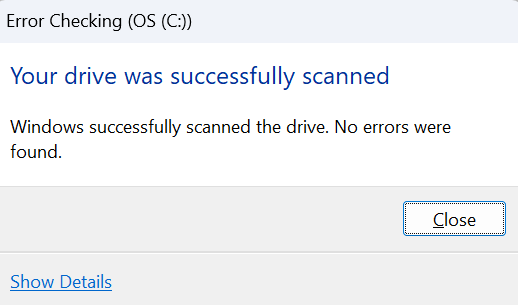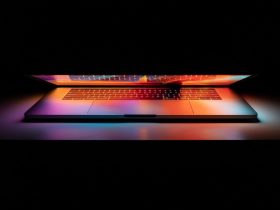Apps quitting? PC shutting down unexpectedly? Worried your files have been corrupted? Don’t panic, help is at hand: Windows offers a nifty, built-in feature called CHKDSK (Check Disk). It analyzes hard-drive errors and runs repairs automatically. (Sadly, it’s not of much use if you’ve physically damaged your hard drive). Learn all about what CHKDSK does and how to use it below. Plus, discover a powerful optimization tool that helps keep your PC healthy and working smoothly.
What is CHKDSK?
As the name suggests, CHKDSK is just that: It scans and repairs your drive. Built into your Windows software, it’s designed to do a disk check (hard drive) for any disk errors in the files and the file system. After CHKDSK finishes a scan, the utility displays a summary of what was found, as well as a status of any actions it performed. CHKDSK isn’t just a convenient tool, but an essential part of good computer hygiene. So, it’s a great idea to get into a routine and use it regularly! In addition to repairing minor hard drive errors, it helps keep your system data organized. It also cleans out your computer which can free up disk space—and this, in turn, can even speed up your PC! So, think of it as a housekeeper for a sparkling clean and more organized and efficient home. And it’s free…so why wouldn’t you?
Now you know what check disk (basically) is, it’s equally important to understand what it is not: It’s not a data recovery tool so it can’t recover or repair lost or damaged files. CHKDSK simply helps ensure that the information currently on your disk is in a safe, working state. If it’s not, the CHKDSK utility attempts to separate the damaged files and save the remnants. As part of its disk checks, CHKDSK scans for ‘bad sectors’—those ruined sections of your hard drive that are either inaccessible or unwritable. Sadly, the data here may be lost for good but at least CHKDSK makes sure that these bad sectors aren’t used again, so data hopefully won’t go missing there again in the future. How do good hard drives turn bad anyway? Often, it’s wear and tear but other common causes can include direct physical damage, manufacturer defects, and software errors.
According to the Windows website, interrupting CHKDSK isn’t recommended. However, canceling, or interrupting CHKDSK shouldn’t leave any files more corrupted than they were before. CHKDSK works for both older spinning hard drives and SSDs, and it can’t harm your computer even if you do interrupt it when it’s working, so it’s always worth a try before you panic (or buy another computer).
Generally, CHKDSK is run via Command Prompt in Windows 10,11 (or Windows 8 and 7) and uses unique commands like chkdsk /f or chkdsk /r to display data errors and fix them. We’ll delve into the details below.
Where and when should I use CHKDSK?
Experts tend to agree that it’s wise to leave 10-15% of storage free as your operating system and some applications may need extra space to function properly. So don’t be tempted to stuff in every last megabyte! If you’re often left staring at that dreaded spinning circle, files are opening more slowly, and programs are taking longer to load, then you may be running out of storage. Deep cleaning your computer of unwanted files and streamlining the folder system helps free up storage space and can boost performance. In a nutshell: Clean out the downloads, file copies, unwanted photos, and other digital dust and you may be rewarded with a faster and more stable machine.
Tools like Avira System Speedup can make it easier to stay on top of your PC cleaning. It can free up gigabytes of space by deleting obsolete and duplicate files, helps clean out the registry, defragments the hard drive, and even helps boost startup speed.
Before you run a CHKDSK, please rule out possible hard drive failure! Look out for these serious signs that may indicate a sick hard drive: Overheating and strange sounds, system crashes, error messages and a blue screen of death, plus major slowdowns, and corrupted data. The spindle that rotates the hard disk can also become stuck causing hard disk faults and failure.
Here’s how to check your hard drive health:
Step 1: Type cmd or command into the taskbar search field and click Command Prompt to open the Command Prompt window.
Step 2: In Command Prompt, type “wmic diskdrive get status” and then press “Enter”. If the status reads “OK”, congratulations! Your hard drive is healthy and you can breathe a sigh of relief.

How to run CHKDSK in Windows 11
Here we’ll show you how to check your hard disk in Windows 11 using three methods: from the graphic user interface (GUI), the Windows command processor (CMD), and via external media.
Not very tech-savvy? Try method 1: Run CHKDSK in Windows 11 from the GUI
Windows gives you the option to run the CHKDSK command in File Explorer, so you don’t have to type commands in the slightly more daunting command center.
- Double-click on the ‘This PC’ icon on your desktop or press the Windows+E shortcut on your keyboard.
- Right-click on the drive you want to scan and then choose “Properties” from the menu.

- The Windows Properties window opens. Click the “Tools” tab and then select “Check” in the Error checking section.

- If there are no errors on the drive, you’ll receive the prompt below. If you still want to continue with the scanning, click on the large “Scan drive” option (in blue) on the prompt. If not, hit “Cancel”.

- This process may take a while so wait patiently. Why not have a coffee?

- When CHKDSK is finished, click “Show Details” to view any errors that were repaired, or click “Close” to close the window.

Alternatively, choose the option below if you want to flex those admin rights muscles and tell CHKDSK precisely what to do.
Do you have admin rights? Choose method 2: Run CHKDSK in Windows 11 from CMD
This offers greater control and more flexibility by using CHKDSK commands with the help of parameters but you’ll need to be logged in as an admin.
- Type cmd (Command Prompt) in the Start menu search bar. Then select “Run as administrator”.
- In the Command prompt window, type “chkdsk/r” or “chkdsk /f /r” and hit Enter. CHKDSK will now scan for drive errors and let you know if any repairs are needed. It won’t fix them without a command though.

Please note that the scanning process in the command prompt requires locking the selected drive.
The /r parameter helps to recover data before it repairs and marks bad sectors. The recovered data is usually saved as text or coded data. If your PC isn’t working well enough for either of these methods, and you’re facing the graveyard that is a blue screen, or a machine that won’t switch on, there is a third option.
For very sick PC’s, try method 3: Run CHKDSK from installation media (Windows 10, 11)
Thankfully, you can still run CHKDSK from any installation media (like a USB) that has your version of Windows on it. This will scan for disk errors and attempt to fix them before Windows boots up.
- Insert the installation media and restart your computer.
- Press the F8 key multiple times before the Windows logo appears.
- When prompted, click on “Repair your computer”.
- Choose “Troubleshoot” and then “Advanced Options”.
- In the Advanced Options, Select “Command Prompt”.
CHKDSK should now identify and remove bad sectors or corrupted data so that your computer will work normally again. You can also install a clean Windows version from your bootable Windows media. Follow the steps above but select “Install Now” during step 3.
Choose your CHKDSK commands here
CHKDSK is a versatile command and supports a variety of parameters (IT instructions) to pinpoint various problems. Here is a handy overview of CHKDSK parameters and their associated functions. Please remember that check disk command will search the disk drive for issues, but it won’t fix them. If you get a notification that says “No further action is required,” you won’t need to use any other commands and your work is done (for now!).
| /f | Scans and fixes errors on the disk. If the volume is in use, you will be notified to schedule the check on the next boot of the computer. |
| /v | Checks the disk and displays the name of each file in every directory on your system. |
| /r | Locates all the physical bad sectors on the drives and recovers readable information. Also includes: Functionalities of the ‘/f’ parameter. |
| /x | Force dismounts the volume and then scans and fixes the drive. Also includes: Functionality of the ‘/f’ parameter. |
| /i | Skips some volume checks for index entries to shorten the time required to run CHKDSK.1 |
| /c | Skips the check cycles within the folder to structure to shorten the CHKDSK time.1 |
| /I[:<size>] | Changes the log file size to your chosen size. If used without the ‘size’ parameter, the command displays the current size. |
| /b | Clears the current list of identified bad sectors on the volume and re-scans the allocated and free clusters for any errors. Also includes: Functionality of the ‘/r’ parameter.1 |
| /scan | Runs an online scan on the volume.1 |
| /forceofflinefix | Bypasses all online repairs, and defects are queued for offline repair. Note: Must be used with /scan. |
| /perf | Increases the priority of the scan and increases the usage of system resources to complete the scan much faster. Might impact other running tasks negatively. Note: Must be used with /scan.1 |
| /spotfix | Runs spot-fixing on the volume.1 |
| /sdcleanup | Clears away unneeded security descriptor data (implies the ‘/f’ parameter).1 |
| /offlinescanandfix | Runs an offline scan and fixes the volume. |
| /freeorphanedchains | Orphaned cluster chains are freed instead of recovering their contents.2 |
| /markclean | Marks the volume clean if no corruption was detected, even in the case ‘/f’ parameter was not specified.2 |
| /? | The help parameter. Displays all supported parameters for CHKDSK. |
1) Can only be used with the NTFS file system.
2) Can only be used with FAT/FAT32/exFAT file systems.
These commands will automatically run on the active drive shown next to your cursor. To run CHKDSK on a different drive, type chkdsk [drive letter]: /f, replacing [drive letter] with the letter of the drive you want to scan. For example, to repair the B drive, enter chkdsk B: /f.
Check disk error messages? Here’s what to do!
Sometimes CHKDSK finds errors but doesn’t try to fix them. Here are some of the error messages you might receive and how to respond.
Message: Repair this drive
This may occur after running the basic CHKDSK command in Command Prompt.
- Close the Error Checking dialog box.
- Open the Command Prompt by typing cmd into the desktop search field and then select “Run as administrator”.
- Type the command chkdsk C: /f. If the drive or replace replace “C” with the letter of the relevant drive.
Message: Your drive is currently in use/read-only mode
This means that the drive you’re trying to scan is currently active and CHKDSK can’t fix it while it’s in use. To avoid the problem, check if any programs are open using the Task Manager.
- On your keyboard and press the Ctrl + Shift + Esc buttons together.
- Choose the open app or process running on the drive that you want to scan. Then click “End task” to force quit that program.

This is a good opportunity for some hard drive maintenance! Look at the numbers in the disk column of your Task Manager to see the disk usage percentage for each program. Ideally, this number should remain under 20%. If you consistently find that it’s closer 100%, then you’ll need to identify and fix the issue. There’s a lot more you can do for a happy hard drive though, so see below for our recommended maintenance program. Regularly investing a little time in spring cleaning goes a long.
Explore our top tips to keep your hard drive clean and healthy
In addition to running the CHKDSK repair and scan utility regularly, there are many other ways you can help your hard drive. Did you know that there’s a national Keep your Computer Clean Day? It’s on February 12 and there’s a social media hashtag: #CleanOutYourComputerDay. A day a year isn’t enough though, so be sure to celebrate many more of these! Follow the simple steps below and read this blog on the fastest ways to speed up a Windows PC.
- Go through your system and delete the giants: This is a fast, easy way to reclaim storage space as all those files add up fast. So, search though all your files to see which big ones you can delete. Do you really need 10 high-res photos of your last burger? Looking for huge files yourself takes time or you can do a search for large files in File Explorer (Press “Windows + E” at the same time to open File Explorer. Select “This PC”. Type “Size: Large” in the search bar).
- Uninstall unnecessary programs: If you don’t need an app or program, ask yourself if it deserves the space it’s taking up. Microsoft outlines the steps to uninstall apps and programs in Windows 10 and 11 here.
- Defrag your hard drive: Did you know that when there’s not enough space on your disk to store an entire file in one place, that file is broken into smaller pieces called fragments? Over time, these can clutter up your computer and slow it down. Defragmentation organizes storage by consolidating files and freeing up space. Follow the instructions to defrag your hard drive site here.
- Clear away temp files: Temporary files are created by an app or operating system while it completes a task. They can accumulate over time and impact the memory available for your computer to run core processes. Inspired to get rid of yours? Clean away temp files by following the steps here.
- Always have a trusted anti-virus. It goes without saying that a healthy PC isn’t burdened by malware. Install a reputable anti-malware to help block all types of online threats. Avira Free Security bundles online security, privacy, and performance optimization tools so you can clean out, help speed up, and keep your precious data safer.
- Run a disk cleanup: There are many file erasure tools available, but Windows offers a free, built-in version that does a quick clean of duplicates and temp files. Simply enter “disk cleanup” into the search box on the Windows taskbar.

It’s worth remembering that nothing lasts forever, and all disks will finally fail or be damaged—probably at the worst possible moment! Taking care of your computer and freeing it of digital clutter will help it perform better and last longer. Now you know how to run CHKDSK, you have a new tool to keep your computer and hard drive in better shape. And to keep on top of everyday maintenance, consider a PC optimizer like Avira System Speedup. For automatic cleaning and a full set of maintenance and backup tools, there’s also a premium version for an annual fee.
Microsoft and the Windows logo are trademarks of Microsoft Corporation in the U.S. and other countries.














